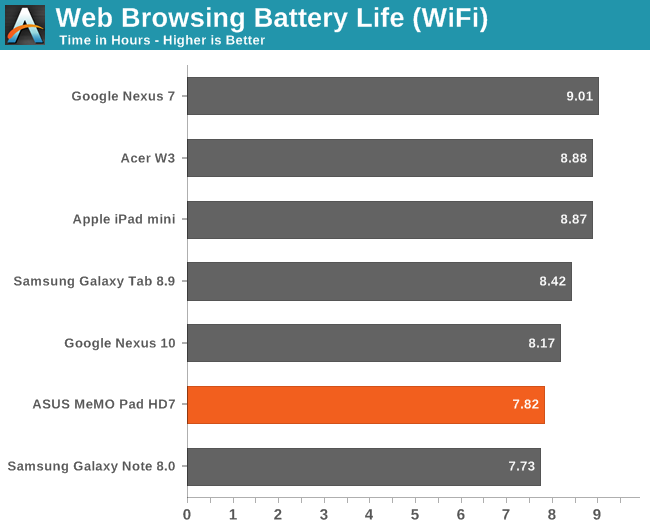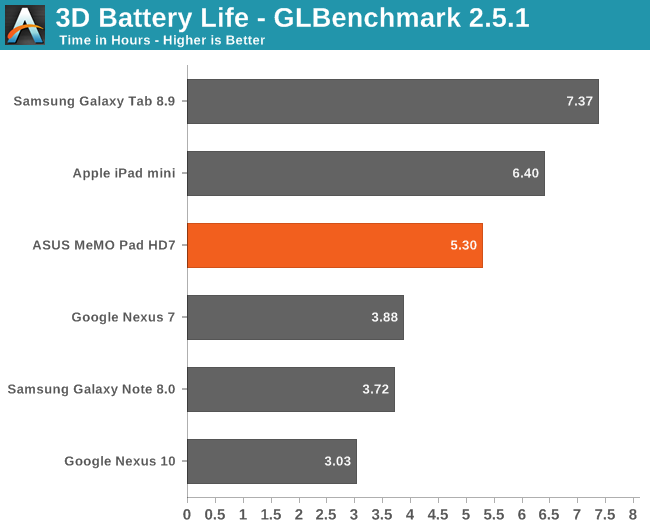ASUS MeMO Pad HD7 Review: $149 Nexus 7.1 Successor & Our First Look at MediaTek's MT8125
by Anand Lal Shimpi on July 29, 2013 3:55 PM EST- Posted in
- Tablets
- Asus
- Mobile
- Android 4.2
- MeMO Pad
Battery Life
The MeMO Pad HD7 includes a 15Wh battery, a ~6% reduction compared to what was in the Nexus 7. The MT8125 SoC on the other hand is likely built on GF's 28nm process, potentially giving it a process advantage over NVIDIA's Tegra 3. There's much more to the platform power consumption story however. Differences in CPU architectures, efficiency of implementation and the surrounding non-CPU IP blocks all play a role in how efficient the MediaTek SoC is.

Normalizing for differences in battery capacity, the MeMO Pad HD7 lasts about 10% less on a single charge than the Nexus 7. Despite being on a lower power process, the MT8125 doesn't seem to be any more power efficient than NVIDIA's Tegra 3. I'm not sure how much of this is a Cortex A7 vs. Cortex A9 thing, and how much of it is the MT8125 just being optimized for cost and not power consumption.

The video playback results are also appreciably lower than the original Nexus 7. I couldn't find any documentation or indication of what video decode IP MediaTek used in the MT8125 but I did notice relatively high CPU utilization during video decode. In the same scenes where Tegra 3's Cortex A9s were running at low utilization/frequencies, I saw 20 - 50% and 1.2GHz on one of the MT8125's A7s.

The one area where the MeMO Pad HD7 ends up more power efficient than the Tegra 3 based Nexus 7 is in our 3D battery life test. Both platforms run Egypt HD at similar performance levels (the T30L Nexus 7 is 15% faster on average), but the MT8125 based MeMO Pad HD7 lasts almost 40% longer. If you normalize for battery capacity, the advantage is even greater. GLB's 3D battery life test has the highest power draw of anything else we run, pointing to idle power optimizations as the biggest problem with the MT8125. What we're seeing here could also be a testament to Imagination Tech's power efficiency advantage over the Tegra 3 GPU.











75 Comments
View All Comments
rabidpeach - Tuesday, July 30, 2013 - link
considering sdhx is mostly a microsoft invention, it might not be well supported in the android universeMonkeyPaw - Monday, July 29, 2013 - link
The big issue now is that places will be clearing Nexus 7.1 stock out. I already see the 16GB listed for $170 (or less for refurbs). You can get a 32GB N7.1 for $199 at Microcenter.Death666Angel - Monday, July 29, 2013 - link
I guess people who want the Nexus experience will still get a Nexus, people who want mSD support, a rare facing camera and a lighter chassis will get the HD 7. And other markets are different as well, here in Germany, the N7 2012 is still at the normal prices: 199€ for the 16GB one over the Play Stor, 238€ for the 32GB one at a normal store with the Play Store being 249€. That makes the HD 7 a lot cheaper, white being 139€ and the rest being 149€, that's not much absolutely, but relatively quite the pay up to get an N7. :)nafhan - Monday, July 29, 2013 - link
So... unless the MicroSD slot is really important, the best bet for bargain hunters may be to look for a deal on last year's N7. I've seen those hit this price point a few times (new).blanarahul - Monday, July 29, 2013 - link
"Like most other quad-core implementations in Android, I rarely see the fourth core turn on. The first two are frequently active, with clock speeds usually up at 1.2GHz whenever you're doing anything (loading apps, scrolling, etc…). The third core usually plugs in to keep responsiveness up while doing anything more CPU intensive, but that fourth core is almost never plugged."I would like to ask. Under what conditions does the 4th core get plugged? How many cores ate used while playing games like Modern Combat 4?
Anand Lal Shimpi - Monday, July 29, 2013 - link
I updated that paragraph a bit to be more specific to the MT8125/MeMO Pad HD7. MC4 tends to use 2 cores from what I've seen:http://images.anandtech.com/doci/7160/Screenshot_2...
peter23 - Monday, July 29, 2013 - link
Maybe all cores might get used if you're streaming music, downloading a torrent and using the nav all at the same time. All cores could get used if you find a video that can only be decoded in software. I don't use Chrome but maybe each tab also uses a separate process like the desktop one. I sometimes open up multiple tabs right after each other and maybe each core will be used to process each tab. These are all guess because I only have a dual-core phone.agentsmithitaly - Monday, July 29, 2013 - link
I'm very happy to see only metric measures except screen diagonals, you guys really listen to your audience!Now what about an Allwinner soc review? Hard to get excited from a performance point of view, but it's amazing to see working 50 $ tablets
abrowne1993 - Monday, July 29, 2013 - link
I feel like there is so much going on in that title.jjj - Monday, July 29, 2013 - link
You should try to find and test a product with Rockchip RK3188 , quad A9 on 28nm with just 25mm2 die size - very curious how it performs and at that size it got to be way cheap.